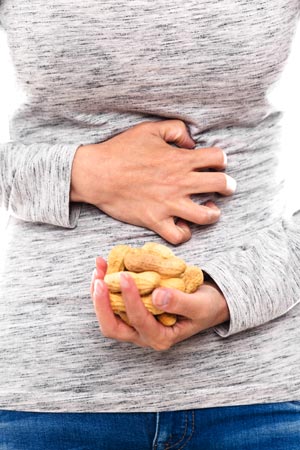Follow us 261.1k
Quick Summary tl;dr
Like other legumes, peanuts are a controversial food among people who follow a keto diet.
They contain anti-nutrients that can reduce their nutritional value and may cause health issues in susceptible individuals.
However, because of their low net carb content and potential health benefits, you may want to include them in your keto or low-carb lifestyle.
Soaking and/or cooking peanuts, choosing organic peanuts or peanut butter, and limiting portion sizes and frequency are key to maximizing their benefits while reducing potential risks.
People who follow a keto lifestyle typically avoid legumes because they are high in carbs. However, peanuts are often viewed as an exception and treated more like tree nuts than legumes. On the other hand, there may be legitimate concerns about consuming peanuts, especially in large amounts. This article discusses the risks vs. benefits of consuming peanuts and whether including them in your own keto diet is a good idea.
What Are Legumes?
Legumes are the edible fruits or seeds of plants belonging to the Fabaceae family of trees, shrubs, and herbs. There are more than 600 types of legumes, but only a small portion are consumed by humans as food, including peas, beans, and peanuts.

Beans, lentils, and peas are often recommended because of their high fiber count. However, they are also low in fat and quite high in digestible carbs in amounts typically consumed, ie, one half to one cup.
By contrast, peanuts are higher in fat and lower in carbs per calorie. Nutritionally speaking, they are similar to nuts, especially almonds ( 1, 2, 3).
|
Total Carbs |
Fiber |
Net Carbs
|
| Black beans, raw, 160 kcal serving |
29 g |
10 g |
19 g |
| Almonds, raw, 160 kcal serving |
4.5 g |
2.4 g |
2.1 g |
| Peanuts, raw, 160 kcal serving |
6.1 g |
3.4 g |
2.7 g |
Nutritional Analysis for Peanuts
Here is the complete nutrition profile for 28 grams (1 ounce) of peanuts ( 2):
|
|
| Calories |
159 kcal |
| Protein
| 7.2 grams |
| Carbohydrate |
4.5 grams (of which 2.4 g is Fiber and 2.1 g Net Carbs) |
| Fat |
13.8 grams (of which 1.8 g (13%) is Saturated, 6.9 g (50%) is Monounsaturated, 4,355 mg (32%) is Omega-6 Polyunsaturated and 800 mg (5%) is Omega-3 Polyunsaturated fat) |
| Vitamin E |
2.3 mg (15% of the Recommended Daily Intake, or RDI) |
| Magnesium |
48 mg (12% RDI) |
| Copper |
0.3 mg (16% of the RDI) |
Peanuts also contain a number of antioxidants in the poyphenol family, including coumaric acid. These polyphenols have been found to protect against free radicals, unstable molecules which can damage cells throughout your body. This is true for both conventional peanuts and those higher in oleic acid, the primary monounsaturated fat in peanuts ( 4).
Potential Health Benefits of Peanuts
In addition to being tasty, portable, and keto-friendly, peanuts may provide a number of favorable health effects.
Weight Loss
Because peanuts are fairly high in calories, people trying to lose weight often receive advice to limit or even avoid them. However, research suggests that rather than contributing to weight gain, including peanuts in your diet may actually promote weight loss and help improve body composition ( 5, 6, 7).

In a four-week study of 65 overweight and obese men, the groups who consumed 56 grams (2 ounces) of conventional or high-oleic-acid peanuts per day as part of a calorie-restricted diet lost more body fat, retained more lean mass, and experienced a greater increase in fat burning than the calorie-restricted control group ( 6).
In another study, when overweight adults increased their energy intake by including peanuts in their daily diet for 12 weeks, they gained far less fat than expected, despite consuming 10% more calories than the control group. The authors suspect that this may have been due in part to incomplete digestion and absorption of calories from the peanuts ( 7).
Whether whole peanuts or peanut butter are best for weight loss isn't clear, based on the research available.
One study of 118 overweight adults reported that consuming peanuts in the form of peanut butter or whole peanuts had similar effects on weight loss and appetite ( 8). However, another study in overweight women with type 2 diabetes gave the edge to peanut butter over whole peanuts with respect to reducing blood sugar levels, increasing satiety, and reducing appetite ( 9).
It's quite likely that some people may lose more weight when eating whole peanuts, whereas others may find that they do better sticking to peanut butter instead.
Reduction in Heart Disease Risk
Overall, research suggests that people who regularly consume nuts, including peanuts, may be at lower risk of cardiovascular disease (CVD) compared to those who don't eat nuts ( 10, 11, 12, 13, 14).

Some of this may be due to improvements in fasting lipids that often occur in response to increased peanut intake, such as higher HDL values and lower triglyceride and LDL values ( 8). But peanuts may also improve the way your arteries work after eating a large meal.
A recent randomized, controlled study found that when 15 overweight or obese men ate 3 ounces (85 grams) of peanuts as part of a high-fat, high-calorie meal, they experienced better arterial function along with lower post-meal triglyceride levels than when they ate a similar meal without peanuts ( 13).
In addition, large observational studies have linked the regular consumption of peanuts and other nuts to reduced heart disease risk.
In a detailed 2017 review of 18 prospective studies, researchers reported that adults who consumed nuts and peanuts more frequently had a lower risk of dying from several diseases, including being 27% less likely to die from CVD. Peanuts and tree nuts were found equally effective at reducing heart disease risk, with as little as 36 grams (slightly over 1 ounce) per week appearing sufficient to provide this benefit ( 14).
Decreased Inflammation
As stated earlier, the chief fatty acid in peanuts is oleic acid, a monounsaturated fat also found in olive oil that appears to help reduce inflammation. Studies have shown that eating more nuts, including high-oleic-acid peanuts, can help reduce inflammatory markers such as tumor necrosis factor, IL-8, and c-reactive protein (CRP) ( 15, 16).
Improvement in Blood Glucose and Insulin Response
There is some research suggesting that blood sugar insulin resistance may decrease in response to the consumption of peanuts, including those high in oleic acid.

Interestingly, one study actually found a quicker return to baseline insulin and blood sugar levels after people ate conventional peanuts compared to the type high in oleic acid, whereas others have shown greater improvements in insulin and blood sugar regulation with high-oleic-acid peanuts than conventional peanuts ( 16, 17).
At this point, it seems that either type of peanut may provide benefits for people with diabetes or prediabetes, similarly to tree nuts.
Potential Health Concerns About Peanuts
Although they may provide beneficial effects on health, peanuts have also been called into question for posing a number of potential health risks.
Allergies
Peanut allergies have increased significantly in recent years. In fact, according to a recent publication in the Journal of the American Medical Association, the number of children reported to have peanut allergies has tripled within the past two decades ( 18).
In susceptible individuals, peanuts trigger a heightened immune response that leads to symptoms like hives, runny nose, wheezing, itching, swelling, and severe gastrointestinal distress.

Moreover, peanut allergy is the leading food-related cause of anaphylaxis, a potentially fatal reaction characterized by tightness in the throat, difficulty breathing, rapid drop in blood pressure, and dizziness that may lead to loss of consciousness. An anaphylactic reaction requires immediate administration of epinephrine and follow-up at the nearest hospital emergency room.
Obviously, people with peanut allergies should avoid consuming peanuts, along with foods that may have been cross-contaminated with peanut residue during processing.
Aflatoxins
Peanuts have been criticized for containing aflatoxin, a toxin produced by the Aspergillus mold that often grows on peanuts. Aflatoxin is also found on other crops, including corn, cereal, and tree nuts.
Small levels of aflatoxin are unlikely to cause harm. However, at higher levels, aflatoxin poisoning may occur, which can lead to liver failure ( 19).
The risk of aflatoxin contamination depends on how peanuts are stored. It's also much more common in warm, humid environments.
One study found that roasting and processing peanuts into peanut butter reduced the aflatoxin content by about 89% ( 20).
Although high aflatoxin concentrations have been found in peanuts in some countries in Africa and Latin America, governmental agencies in other countries strictly enforce limits on the amount of aflatoxin allowed in peanut butter and other peanut products ( 21).
Phytic Acid
Phytic acid is a compound found in many plant foods, including nuts, seeds, peanuts, beans, and grains. Phytic acid can inhibit absorption of certain minerals, including iron, calcium, and zinc ( 22).
However, under normal conditions, your body has the ability to compensate for high phytic acid intake. In a study of women who had low iron stores but were not anemic, consuming a high-phytate diet for eight weeks actually ended up increasing iron levels more than consuming a low-phytate diet for the same time period ( 23).
Moreover, phytic acid is usually not a concern among those who eat a balanced diet that contains meat, fish, and other sources of animal protein, because these foods enhance mineral absorption. Vegetarians may need to be more careful about the amount of phytic acid they consume.
Finally, animal research suggests that phytic acid may help protect against cancer and other diseases ( 24).
Lectins
Peanut agglutinin is a lectin, a type of protein found in plants that can bind to cell membranes. Lectins help plants defend themselves against insects and pests. In humans, lectins are resistant to digestion, which can cause the body to produce antibodies to them. In certain susceptible people, including those with autoimmune disease, an overly robust immune response could potentially exacerbate their symptoms.

The way a body handles lectins depends on the type, amount consumed, and individual response. For instance, the agglutinin found in kidney beans can cause severe food poisoning if the beans are raw or undercooked.
However, the lectins in uncooked peanuts don't pose the same kind of risk. In addition, peanut lectins are present in lower concentrations than the lectins in beans.
Some researchers feel that peanut lectins may be responsible for the atherosclerosis (fatty deposits in the arteries) that occurs when rodents and rabbits are fed a high-cholesterol diet that also contains peanut oil ( 25). Importantly, although no similar human experiments exist, as stated earlier, moderate peanut consumption appears to be cardioprotective based on several studies.
There is some research in cancer cell lines and animals linking peanut lectins to cancer progression ( 26, 27). In 2014, a group of researchers suggest that tumor growth may spread more rapidly in cancer patients who eat peanuts, which could ultimately increase their risk of dying from the disease ( 27). For this reason, those with cancer may be best off avoiding peanuts or consuming them very infrequently.
On the other hand, people who don't have cancer might want to include peanuts in their diet, at least occasionally. Several studies suggest that peanuts and peanut butter may help protect against breast, cervical, esophageal, and gastric cancers ( 28, 29, 30).
High Omega-6 to Omega-3 Fatty Acid Ratio
Although peanuts contain far more monounsaturated fat than saturated or polyunsaturated fat, their omega-6 to omega-3 polyunsaturated fatty acid ratio is extremely high. Most tree nuts also have high omega-6 to omega-3 ratios, although none as high as peanuts.
If you consume a well-balanced diet that contains plenty of foods rich in omega-3- fats like fatty fish, flaxseed, and chia seeds, eating small amounts of peanuts shouldn't jeopardize your overall omega-6 to omega-3 ratio.
Peanuts Are Easy to Overeat
It's also worth mentioning that just like with nuts and seeds, and also with full-fat dairy, some people find peanuts – and especially peanut butter – very easy to overeat. If you find these foods nearly impossible to consume in small amounts, avoiding them altogether is probably your best bet.
Making the Healthiest Peanut Choices
Whether to eat peanuts is a personal choice that should be based on your own personal tolerance and health. If you do decide to eat peanuts, here are some ways you can reduce their potentially negative side effects:
Soak, Boil, or Roast Your Peanuts

Soaking certain legumes can help reduce their phytic acid content by up to 50%, although the extent to which this occurs in peanuts is unknown (31). Boiling, roasting, or other methods of heating peanuts can reduce their lectin concentrations. In addition, soaking and/or cooking peanuts can make them easier to digest and less likely to cause GI discomfort or other symptoms.
Opt for Organic Whenever Possible
As with all foods, select organic peanut butter and peanuts grown as naturally as possible to avoid pesticides and other contaminants.
Keep Peanut Consumption Moderate
In the studies cited above, consuming between 7 to 56 grams (up to 2 ounces) of peanuts per day led to health benefits. Although tolerance to peanuts varies from person to person, it's probably not a good idea for anyone to eat unlimited amounts of them.
Do you like this post? Share it with your friends!
Let us know what you think, rate this post!
